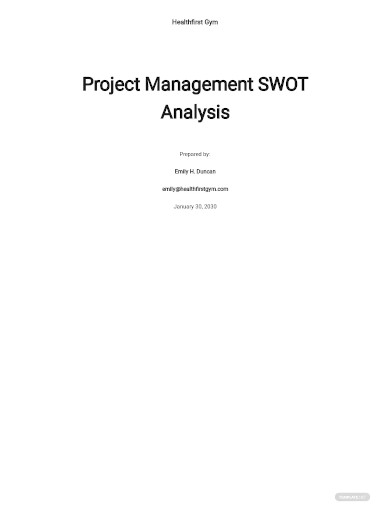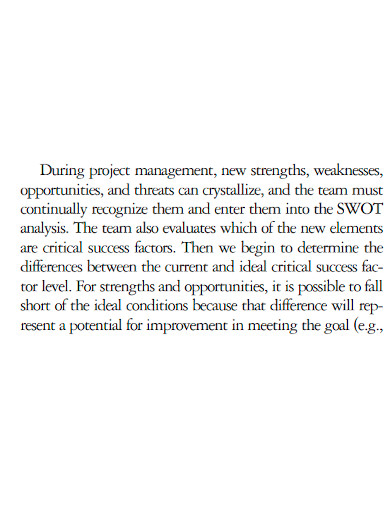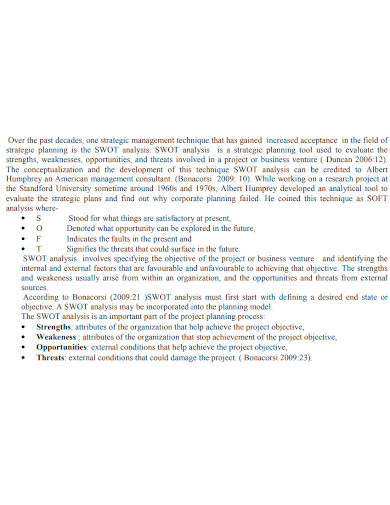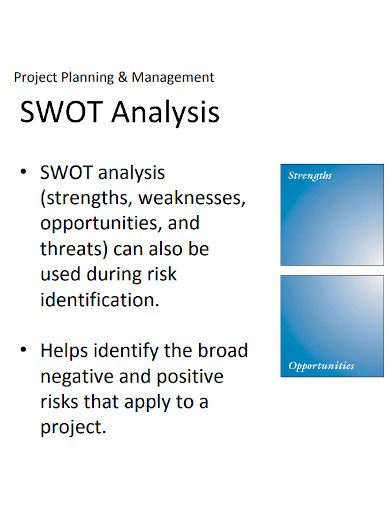Project management is important to help your organization or business to operate smoothly and efficiently. It allows your management team to focus on the work that could improve the state of your organization or business and reduce factors that affect the efficiency of your operations. One of the things that project management is responsible to do is SWOT analysis. It is a useful process that helps project managers identify internal and external factors that could make or break your project. Read the article to know how to do a project management SWOT analysis.
3+ Project Management SWOT Analysis Samples
1. Project Management SWOT Analysis Sample

2. Construction Project Management SWOT Analysis
3. Printable Project Management SWOT Analysis
4. Project Planning and Management SWOT Analysis
What Does SWOT Analysis Means?
A SWOT analysis is a strategic technique that businesses use to assess their organization and project managers do to evaluate their current projects. This analysis can help them better understand how likely they are to succeed and what areas they should focus on to improve. For project managers, incorporating the SWOT analysis in project management will greatly improve their planning, reduce risks, and increase the chances of being successful in their projects. The four focus areas that make up the acronym SWOT are strengths, weaknesses, opportunities, and threats.
How to Write Project Management SWOT Analysis
1. Include all Project Stakeholders in the Analysis
As the project manager, you’re mainly responsible for identifying the SWOT aspects of your project. However, you don’t need to do all the hadrwork alone. Include your team members, your clients, others who are involved in the project to help identify and analyze critical factors of SWOT so that nothing is overlooked.
2. Start With Strengths
Your strengths are the factors that set your project for success. Project strengths include any aspects of the project that make it likely to succeed. Think of the areas in your project that you can identify as your strengths. List as many as possible. Some examples of strength areas are brand recognition or value, supplier relationships, project management software, skills, experience, and client relationships.
3. Identify Your Weaknesses
After listing down your strengths, it’s now time to focus on the weaknesses of your project. Weaknesses are factors that might be a hindrance for your project to succeed. Look at all the resources and processes and procedures you do in your project and identify which can be deemed as weaknesses. Some examples of weak areas in the project can be the speed of response, delivery quality, skill sets, lack of project funding, lack of visibility of progress, disengaged stakeholders, etc.
4. Look For Opportunities
The next thing to do is to identify the opportunities you can find in you project. Opportunities are factors that are outside of your control that could help your project succeed, so you need to focus on the areas that could drive your project forward. You can use the list you did in the strengths sections and find opportunities relating to it. Some examples of opportunities are when you get discounts from suppliers it is an opportunity to save your project some money. If another project finishes early, it could free up resources you can then use to help your project succeed.
5. Identify the Threats
The last areas to identify are the threats. These are external factors that could harm your project if they were to happen. To identify your threats, you must consider your competitors, or external market (if applicable) and other processes or aspects that you may deem as a threat. Some examples of threat areas are competitive activity in client base, increased costs of supplies, materials, or contractors, economic climate and health of your staff, legal, political or social changes jut to name a few.
6. Refine Your SWOT Lists
Once you’ve listed down your all the SWOT list, it’s time to review and revise them to make them more cohesive. Remove any duplicates and make sure they are all specific and accurate. Make each list is factual and based on observation and study, not an opinion of any of the project stakeholders working in the analysis.
7. Create a Plan
Once you’re done refining your SWOT lists, it’s time to create your action plan to address the SWOT factors that you identified and analyzed. This plan must include a means of identifying that the opportunity or threat has happened, as well as the action plan for taking advantage of them.
FAQs
What SWOT category that is overlooked the most?
The category that is often overlook is the threat category. Threats can be sometimes not obvious and it is easy to overlook which makes it challenging to identify threats.
What is the most difficult part of the SWOT analysis?
The most difficult part of SWOT analysis is identifying and analyzing the opportunities because it is tricky to know if a certain area is deemed as an opportunity; however for startup businesses or projects, this part is easier to identify since they can use the reason of starting their business or project as the opportunity.
Conclue your SWOT with a strong conclusion paragraph that summarize your most important findings. Make sure that the SWOT analysis present a clear vision for growth and how you will realistically address the project’s weaknesses and potential threats. Make sure to proofread, edit, and revise your analysis to get rid of errors. To help you get started making your SWOT analysis, download our free sample templates above to use as your reference!
Related Posts
FREE 10+ Fishbone Root Cause Analysis Samples in PDF
FREE 11+ Cost Volume Profit Analysis Samples & Templates in PDF | MS Word
FREE 6+ Corporate Portfolio Analysis Samples in PDF
FREE 10+ Fault Tree Analysis Samples in PDF
FREE 10+ Comp Analysis Samples in PDF
FREE 10+ Fishbone Analysis Samples in PDF
FREE 10+ Individual Swot Analysis Samples in PDF
FREE 10+ 5 Year Analysis Samples in PDF
FREE 10+ Benefit Costs Analysis Samples in PDF
FREE 10+ Job Hazard Analysis Samples in PDF
FREE 10+ Primary Source Analysis Samples in PDF
FREE 10+ Critical Path Analysis Samples in PDF
FREE 10+ Competition Analysis Samples in PDF
FREE 10+ Activity Hazard Analysis Samples in PDF
FREE 10+ Risk Benefit Analysis Samples in PDF



